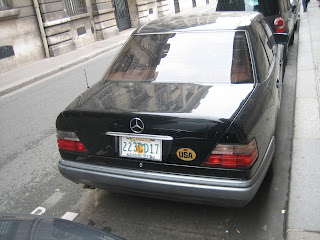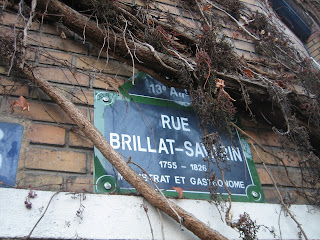It's a common refrain that Paris is a great walking city. From the general feelings evoked by passing through neighborhoods to the infinite details contained in each one, Paris is a great place to perambulate aimlessly. However, it's also enjoyable to stroll with intent. There are many walking guides available to lead you around Paris. Many offer such amazing sights as Notre Dame! the Louvre! the Eiffel Tower! Kind of dull and predictable. These are great things to see, but do you really need help finding them? If the disembodied voice of a Rick Steves audio guide in your ear is your idea of a good way to experience Paris, you might be beyond hope.
There are a couple problems with most Paris guides, walking or general. First is the number of famous sights. The checklist is long enough to eat up any vacation time. It's stressful business seeing everything you are supposed to see, let alone taking a chance on something lesser known. Second, many guides refer to outdated, clichéd notions of Paris: "Bohemian Montmartre" "Artist's Enclave Montparnasse" "Elegant Champs Élysées" Look around when you reach Place du Tertre in Montmatre- these are not bohemians, they're from Ohio. And while the H&M on Champs Élysées is my favorite outpost of the chain, it lacks the moneyed grace of the Avenue referenced in many guidebooks.
What Lia and I have been searching for are guides written for people who are going to be in Paris more than one week. Something more than a list of who died/lived/fought here. We recently found one in an obvious but kind of unexpected place- the City of Paris website. Paris.fr has a large collection of walking tours for every investigative inclination- parks, history, neighborhoods, monuments, etc. We have done two walks thus far, and both have been great. The first was the Butte-Aux-Cailles neighborhood walk. The second, which we did yesterday, was an exploration of "parks secret and romantic" in the 7th Arrondissement. The website offers some information in English, but the bulk of it is in French. I have found the Google Translation Toolbar an effective alternative to actually learning the language.
First stop: Square Récamier, a beautiful shade garden tucked away in the low middle area of the block. It was the first time we have ever been the only people in a park in Paris.
We will be back when things bloom.
Lia near the entrance
moss!
Lia at an entrance to Le Bon Marché, the first department store in Paris, founded in 1852, near Square Récamier. The tilework, from 1876, advertises ribbons(rubans) and lace(dentelles).
Heading west on rue de Babylone, we visited le Jardin de Catherine Labouré.
La Pagode cinema, founded 1896.
Lost stuffed animal and moss on the wall of the Rodin sculpture garden.
We recommend the Rodin museum, but did not visit on this walk.
the golden dome of l'Hotel des Invalides- the military history museum
signs on power generators parked on Boulevard des Invalides
partial translations:
left: Don't urinate here, thanks.
right: Watch the cables when pissing!!! There's juice(electricity)!!!
There's a great place for pissing 10 meters to the left!!
The 7th is home to many embassies and government offices.
Why did we send a Floridian?
lightpost and entrance of Ministry of Defense
Basilica Sainte-Clotilde
I'm guessing that's Ste-Clotilde impaled on the middle peak.
a typically beautiful church
visible hair on a female religious figure struck us as uncommon
sculpture in the park in front of Ste-Clotilde
we argued about textual analysis
At 4:30 on Sunday afternoons, Notre Dame offers free concerts of sacred music featuring a different organist every week. Yesterday we heard Marcel Dupré's "Symphonie Passion" performed by Alain Bouvet. It was a relaxing end to a pleasant afternoon.
the organ at Notre Dame Cathedral



















































